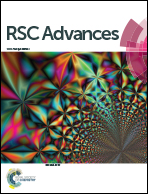Influence of microwave hydrothermal reaction factor on the morphology of NaY(MoO4)2 nano-/micro-structures and luminescence properties of NaY(MoO4)2:Tb3+†
Abstract
The reaction conditions including exterior and interior factors in hydrothermal syntheses play very important roles. In this work, the influences of pH, Cit3−/Ln3+ and MoO42−/Ln3+ on the crystal structure and morphology of NaY(MoO4)2 microstructures derived from a microwave hydrothermal synthesis were systematically studied. It was found that certain morphologies of the NaY(MoO4)2:Tb3+ particles were only formed at critical pH values, and different amounts of Na3Cit and Na2(MoO4)2 in the reaction solution functioned in opposite ways in the crystal nucleation and growth. We also proposed that the competitive equilibrium between Na3Cit and Na2(MoO4)2 was responsible for the self-assembly behavior of the NaY(MoO4)2:Tb3+ nano-/micro-crystals. Based on the possible growth mechanism of the NaY(MoO4)2 microstructures, additional Cit3−/MoO42−/Ln3+ molar ratios for preparing the target products were designed and the corresponding samples were prepared. It was proven that the self-assembly behavior of the NaY(MoO4)2:Tb3+ crystals can be successfully modified under certain Cit3−/MoO42−/Ln3+ molar ratios. We also discovered that the morphology can slightly affect the luminescence intensity of the NaY(MoO4)2:Tb3+ phosphors. The temperature and concentration quenching behaviors of the NaY(MoO4)2:Tb3+ phosphors were studied. The crossover process was found to be responsible for the temperature quenching of 5D4 fluorescence, and the electric dipole–dipole interaction was proven to be the physical nature of the concentration quenching and the fluorescence decay process.


 Please wait while we load your content...
Please wait while we load your content...